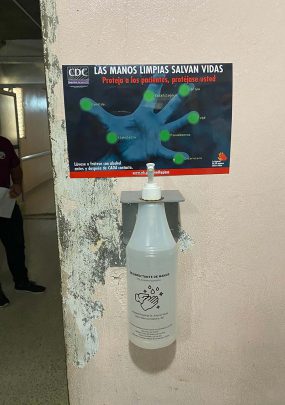Social and Behavior Change Activities
Health behaviors are complex and influenced by many factors within an individual and their social and physical environment. These can include a person’s health knowledge and beliefs, social norms, environmental factors (such as water access), and local or national rules and policies.
What Is Social and Behavior Change?
Social and behavior change (SBC) activities use theory-driven approaches from communications, behavioral economics, sociology, and psychology to encourage positive change in health habits.
Effective SBC activities are:
- Context appropriate. Activities are tailored to specific populations by listening to the needs of a community and understanding their perspectives on the issue. Community engagement is at the core of effective social and behavior change and is important to developing appropriate programs.
- Inclusive. Activities are accessible to everyone in the target population, including women, people with disabilities, children, and other marginalized groups.
- Data driven. The design of the activity or program is evidence-based and considers people’s beliefs and practices. It also addresses stated needs.
- Practical. Activities are easy to carry out with existing facilities and services. Potential change agents in the community will be able to practice and promote activities easily.
- Sustainable. Activities can be extended beyond the limits of a project funding cycle to achieve long-term change.
- Complementary to clinical services. SBC activities do not replace existing healthcare systems and clinical services to address health issues; instead, they work together.
How CDC Uses SBC in Global WASH

CDC Behavioral Scientist Christina Craig (right) and nurse Dania Romero (left) pose with a message-tested hand hygiene poster and new ABHR dispenser in regional hospital in Moca, Dominican Republic.
SBC activities are central to the success of CDC’s WASH activities. CDC uses behavior change activities to promote healthy behaviors like handwashing, using sanitation facilities, and following safe food and water handling practices.
CDC’s Global WASH team focuses on these key behaviors:
- Consistently washing hands or using alcohol-based hand rub (ABHR) at recommended times, depending on setting (e.g., community or healthcare)
- Safe use and management of toilets and latrines, including proper cleaning and disinfection of latrine/toilet cabins and use of appropriate personal protective equipment (PPE) when emptying latrines
- Reducing household water contamination by encouraging hygienic water collection, transportation, treatment, and storage practices
- Supporting communities to manage and repair their WASH facilities to promote sustainability
Activities used to encourage WASH behavior change include:
- Engaging interested community groups in development of priorities, planning, and implementation
- Disseminating [or sharing] messages that target barriers and facilitators of the desired behavior and reach priority demographics
- Creating environmental nudges, such as prominently placing soap and water stations, installing footpaths leading users from toilets to sinks, and hanging posters promoting WASH behaviors near hand hygiene stations
- Developing communication materials, such as flyers, handouts, stickers, and posters
- Installing highly visible murals to promote WASH messaging in communities
- Providing tools to help people maintain their WASH systems
- Mobilizing community members to be changemakers
- Increasing local capacity for promoting behavior change by supporting local partners such as health departments, healthcare facilities, schools, and other community institutions
Ongoing SBC Activities with CDC’s Global WASH Program

Message-tested hand hygiene posters accompany ABHR dispensers in regional hospital in Moca, Dominican Republic.
Environmental Nudges
Nudges can take many forms and are one example of a behavior change tool that can encourage people to wash their hands. CDC collaborates with schools and communities to increase handwashing adherence by:
- Installing handwashing stations and soap dispensers in high-traffic areas in markets and points of entry
- Relocating or installing handwashing facilities so they are directly in a person’s path when exiting the toilets
- Painting colored footpaths between toilets and handwashing facilities in schools to encourage students to wash hands
- Drawing arrows and messages above handwashing facilities in schools to encourage people to use soap and wash hands for 20 seconds
Hand Hygiene Champion Initiatives
Hand Hygiene Champions are trained to encourage hand hygiene practices among their peers and communities. CDC is supporting projects to train Hand Hygiene Champions in healthcare facilities (Dominican Republic) and communities (Uganda). In healthcare settings, Hand Hygiene Champions share key hand hygiene messages with staff in weekly meetings and encourage hand hygiene practice among staff to help prevent healthcare-associated infections. In community settings, Hand Hygiene Champions spread hand hygiene messages during community events to provide their peers and community members with constant reminders to wash their hands at recommended times.

Hand Hygiene Champions pose in front of ABHR dispenser in San Pedro de Macoris, Dominican Republic.
Tools for Managing WASH Systems
Properly maintaining public WASH facilities like handwashing stations and latrines is an important behavior for ensuring that people always have access to functional and safe WASH services. CDC and partners have created resources to help managers of public locations make sure that functional, safe handwashing stations are always available and sanitation facilities are always clean and properly managed. These resources include written guidelines with tips for maintaining WASH facilities, budgeting for repairs, and setting daily maintenance tasks. They also include visual aids with cleaning and disinfection instructions and steps for making low-cost hand soap and cleaning solutions.
Qualitative Research
To help understand the drivers and barriers of WASH behaviors in different populations, the team uses theoretical frameworks such as the Integrated Behavioral Model for Water, Sanitation and Hygiene (IBM-WASH) and the COM-B Model to develop qualitative research tools and interpret results.
Information, Education, Communications (IEC) Materials Campaigns
CDC has developed and disseminated handwashing IEC materials (such as posters and fact sheets) globally to partners. These resources support IEC activities by raising awareness on handwashing topics, including key times to wash hands, when to use hand sanitizer, and how to create handwashing solutions. These resources are publicly available and can be found on the Global WASH Communication Resources page.